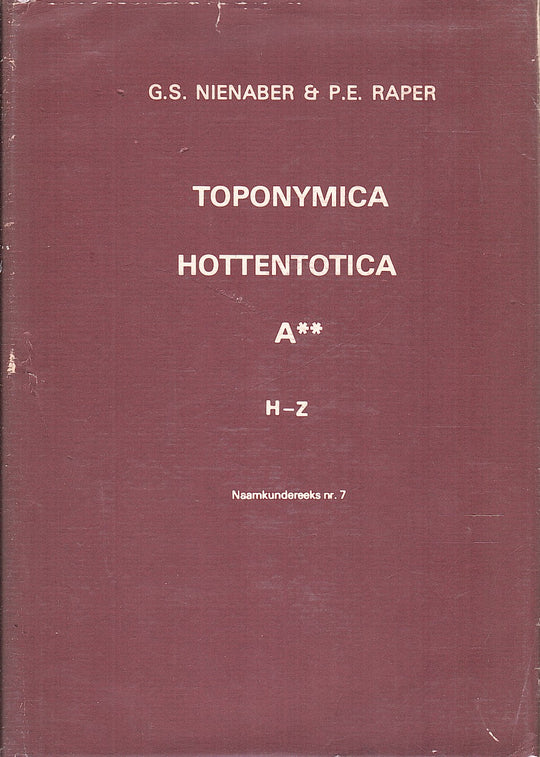eng
It is about the Cutting River, a water location on the river and the vlei, the Tsondabvlei, Very Walvis Bay. There are also other exchange forms. Here are all kinds of problems. Dove clearly struggles to hind the meaning and leaves Tson to Tsom- for a statement he gives and who joins the statements for eg. Tsumis 2317. Nama has a word Tsuni = 'Schmelzen' (Kr.- R. 1969 NW 389) which also pose possibilities, viz. That water 'melts', so about 'sinking-' or 'Sakrivier', with the lockǃ A-B = River. This leaves the -D unexplained. Krenz offers an acceptable way out. So maybe, as also at DEHL, 'Sandings River'? or 'Package River'? Notably that PNC has also treated the case Tsondab and then received no declaration of the meaning. VIEABLE IS THE OPERAGED GENERAL SPELL HERE ABOUT THE INTERPRETATION OF THE COMPONENT TSI-TSI There is different Adjektiva / Adverbia. There was also thought of rain, now for the forest where the falling drops are heard sound -Eisi for clean, beautiful, or at ^ Gi- ^ GI, also = blinding (bright)? Gordon also does not explicitly mention the Khoekhoian word, though by implication. With -Camma = water, river, deducted, remain over sites, and if the name means 'water begins,' then sites = 'start'. We have no old-Cape recording for 'start'. In Nama of this day it is Tsoa-TSO (Rest 1960 DNW 3), and Tsoa-Tsoa-S = 'Der Anfang' (Kr.-R 1969 NW 384). It will then be involved on the river's origin , we think. Determine that He is trustworthy.
afr
Dit gaan hier oor die versandende rivier, ’n waterplek aan die rivier en die vlei, die Tsondabvlei, distrik Walvisbaai. Daar is ook nog ander wisselvorme. Hier is allerlei probleme. Dove sukkel duidelik om die betekenis te agterhaal en vertrek Tson- tot tsom- vir 'n verklaring wat hy daar gee en wat aansluit by die verklarings vir bv. TSUMIS 2317 alwaar. Nama het ’n woord tsuni = 'schmelzen' (Kr.-R. 1969 NW 389) wat ook moontlikhede inhou, nl. dat die water daar 'wegsmelt', so ongeveer 'Wegsak-' of 'Sakrivier', met die slot ǃa-b = rivier. Dit laat die -d- onverklaar. Krenz bied daar ’n aanneemlike uitweg. Dus miskien, soos ook by Diehl, 'Versandingsrivier'? of 'Wegsakkingsrivier'? Opmerklik dat PNK ook die geval Tsondab behandel het en toe geen verklaring van die betekenis ontvang het nie. Wyselik is die oorgelêwerde algemene spelling hier darem onveranderd gelaat. van Humansdorp. Oor die interpretasie van die komponent Tsi-tsi- is daar verskil van opvatting. Die reduplikatiewe vorm het, soos gewoonlik die geval met sulke bousels, die waarde van versterking. Pettman gaan uit van tse-tse (vir blink, helder, wat op die water slaan) plus -sa, die formans van passiewe adjektiva/adverbia. Daar is ook gedink aan reen, nou i.v.m. die woud waar die vallende druppels klanknabootsend gehoor word. Oor klanknabootsing kan mens moeilik praat. Dit is egter nie vir ons seker aan watter woorde Pettman sy afleiding verbind nie. Is dit aan etsi-etsi vir skoon, mooi, of aan ^gi-^gi, ook = verblindend (helder)? Gordon noem ook nie uitdruklik die Khoekhoense grondwoord nie, wel by implikasie. Met -camma = water, rivier, afgetrek, bly oor sitse, en as die naam beteken 'Water begin,' dan moet sitse = 'begin'. Ons het geen Ou-Kaapse optekening vir 'begin' nie. In Nama van van- dag is dit tsoa-tsoa (Rust 1960 DNW 3), en tsoa-tsoa-s = 'der Anfang' (Kr.-R 1969 NW 384). Dit sal dan te betrek wees op die rivier se oorsprong, meen ons. Hoe ook al, ons sien geen goeie rede om nie die voorkeur te gee aan Gordon se verklaring nie. Hy het Khoekhoens geken, hy het besondere belangstelling vir die betekenis van plekname gehad, en ons het by ander gevalle nog steeds kon vasstel dat hy betroubaar is.




